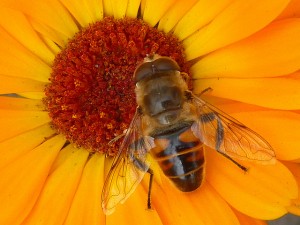 A third of the fruits and vegetables we eat depend on bees for pollination. That’s a lot! Bees play a crucial role in the ecosystem as pollinators, which is why their recent decline is such a critical environmental issue.
A third of the fruits and vegetables we eat depend on bees for pollination. That’s a lot! Bees play a crucial role in the ecosystem as pollinators, which is why their recent decline is such a critical environmental issue.
A few of the fruits that are dependent on bees for pollination: strawberries, oranges, peaches and apples. Any of your favorites there?
Bee populations have been dying mysteriously throughout North America and Europe since 2006, but the cause behind the decline, known as Colony Collapse Disorder, has eluded scientists.
Pesticides may be to blame. How can you help?
Plant a bee friendly garden
Bees love flowers but are programmed to visit native plants. Think local and choose plants that will not only thrive in your garden but will also help your neighborhood bee population. A quick Google search for native plants will give you all the information you need or ask your local gardener.
What types of flowers are attractive to bees?
Surprisingly, not all! Some flowers are more attractive to bees. Bees enjoy lupines, purple coneflowers, sage, sunflowers and many more. From Urban Bee Gardens:
The more of these attractive flowers planted in the same place, the better! One of the most interesting results of our research is that bees have preferences, not only for the flowers they pollinate, but for the gardens they visit. Gardens with 10 or more species of attractive plants attracted the largest number of bees. In these kinds of gardens, even those plants known to be less attractive, received higher levels of visits.
When planning your garden this summer, consider planting 10 or more native plants and help your local bees flourish this summer. Help the bees thrive and survive!
Resources:
What You Can Do from the Honeybee Conservancy
Creating a Great Bee Garden by Urban Bee Gardens
Researchers Recreate Bee Collapse
Featured image courtesy of Eurapart via Creative Commons.
